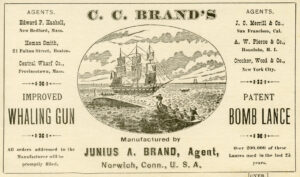During the early 18th century, residents of Nantucket began to examine the bodies of large sperm whales that occasionally became lost and washed up on the shores of their small island. What they discovered in their examination of these large cetaceans would have an enormous economic impact on the nascent whaling industry of the New England colonies. Sperm whales were given that moniker because their boiled blubber fat rendered a high-quality oil that burned brighter and longer than other oils, making it ideal for candles, lamps, and mechanical lubricants. Unlike the smaller species of whales that could be caught in the cold waters of the North Atlantic Ocean, the sperm whale’s natural habitat was the warmer and deeper waters of the southern hemisphere.
During the decades that followed, the demand for this high-quality sperm oil increased. Cities like London and Paris began adopting extensive systems of street lamps lit by sperm oil, successfully reducing night crime. As the Industrial Revolution rapidly evolved, it produced machines that required high-quality lubricants for their daily operation. To meet this demand, larger whaling ships were constructed for lengthy voyages to the deeper, warmer waters where the sperm whales thrived in abundance. These larger ships also had a greater amount of space to accommodate the extraction, processing and storage of the whale’s oil on the ship itself. The headquarters for the whaling industry gradually shifted from Nantucket Island to New Bedford, MA and New London, CT where deeper natural harbors more easily accommodated these larger whaling vessels.
Capturing a sperm whale was a very risky endeavor. Initially, whale-men relied on hand-lances to inflict a mortal wound after the whale had been harpooned. The need for a safer and more effective killing method led to the development of the explosive lance. The first bomb-lance patented in the United States in 1846 for killing whales was invented by Oliver Allen of Norwich, Connecticut. This instrument was designed to be projected from a gun, combining the force of impact with an explosive charge to kill or severely wound the whale.
In 1849, Allen sold his gun manufacturing business, including his patented shoulder gun bomb lance to Christopher C. Brand in Norwich, CT. Brand made significant improvements in the design and manufacture of the bomb-lance for which he received a patent granted in 1852. His contributions were later perfected by his son, Junius A. Brand, making the Brand lances a global standard in the whaling industry. Brand lances typically featured cast-iron shells, with heads that had three cutting edges. They were exploded by a time fuse ignited by a primer, which was activated by the gun’s discharge.
The U.S. whaling industry had thrived for over one hundred years, peaking in the 1850’s. Substitute lubricants derived from petroleum and cottonseed oil gradually began to erode the demand for sperm oil. Between the years 1850 and 1865, approximately sixty percent of the U.S. whaling fleet was permanently retired.

